What are macros? | How to calculate your macros | How to track your macros | Macros troubleshooting and FAQs | What to eat on a macro diet | How to measure portions | Macros and consistency | Macros for weight loss | Macros and alcohol
Lose weight, gain muscle, and perform better.
But in exchange, you have to do math.
Still with us?
Then maybe you’d like to learn how to count macros.
Counting macros is a way to track food intake using grams of protein, carbs, and fats (macronutrients) instead of calories.
The advantage of focusing on macronutrients over calories is that it tells you a bit more about the quality of your food, and how it affects your body.
The disadvantage of tracking macros is that you have to plan, measure, and record everything you eat. And then you have to do math to add up your macronutrient tallies at the end of each day.
For most people, that can be a bit confusing and intimidating, especially when you first get started.
That’s why we created this comprehensive guide to everything macros.
You’ll learn:
- What macronutrients are and what foods contain them
- How to calculate and track your personal macronutrients
- Why macronutrients aren’t the full story when it comes to health
- Who macronutrient tracking works best for (and who it doesn’t)
What are macros, anyway?
Macros, or macronutrients, are large groups of nutrients.
There are three main macronutrients: Protein, carbohydrates, and fat.
(Technically, alcohol is a fourth macronutrient, but nutrition plans don’t focus on it because it doesn’t offer much in terms of health benefits.)
Most foods and beverages are made up of a combination of these three macronutrients. But many foods have one dominant macronutrient that provides the majority of the calories.
For example:
- Brown rice is mostly carbohydrate but also has a bit of protein and fat.
- Cashews are mostly fat but also contain protein and a bit of carb.
- Lean chicken breast is mostly protein but also contains some fat. It doesn’t contain any carbohydrates.
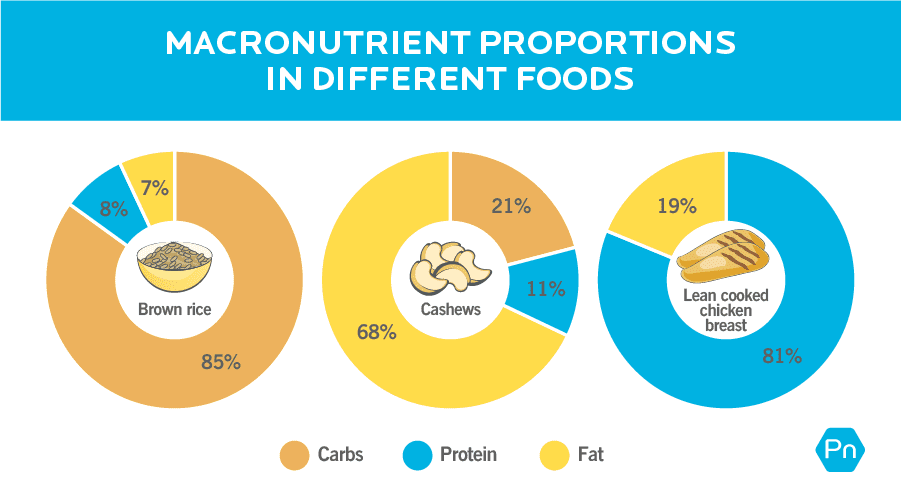
Each macronutrient provides a certain number of calories:
- 1 gram of protein = 4 calories
- 1 gram of carbohydrate = 4 calories
- 1 gram of fat = 9 calories
- (1 gram of alcohol = 7 calories)
As a result, tracking macros means you’re automatically tracking calories.
Why are macronutrients important?
Your body breaks down macronutrients to perform specific jobs in the body.
For example:
- Proteins break down into amino acids, which can affect our muscle composition, and are involved in creating mood-regulating neurotransmitters.
- Carbohydrates break down into sugars, which give us energy for immediate use, but also storage.
- Fats break down into fatty acids, which help form certain structures of our body, like our brain, nervous system, and cell walls.
So, in addition to impacting your body weight and composition, macronutrients can impact how you feel, perform, and even behave.
How to calculate your macros
If you’re eager to get your personalized macros plan, a heads up before you start:
Once you get your macro numbers, you’ll want to stick to them for at least two weeks.
It takes that long to determine whether any changes you notice are due to your plan working (or not working), or just regular body fluctuations.
After two weeks, you can evaluate how things are going, and adjust your calories / macros up or down as needed. All of the methods below provide estimates of your daily calorie and macro needs, so in most cases, it takes some experimenting before you find what works for you.
Ok, let’s crunch those numbers.
Step 1: Calculate your energy (calorie) needs.
Macro counting is based on the calories in, calories out (CICO) principle: When you take in more energy than you burn, you gain weight, and when you take in less energy than you burn, you lose weight.
(Learn why CICO is indisputable: Calories in vs. out? Or hormones? The debate is finally over.)
So before you work out your macros, you have to figure out your energy (calorie) requirements, based on your body, lifestyle, and goals.
Here are two ways to do that.
Option 1: Use our Macros Calculator.
There are plenty of nutrition calculators out there, but ours is—lowkey brag coming up—special.
Most calculators determine your maintenance calorie needs using static formulas. Then, they simply chop 500 calories per day or lower the calories 10 to 20 percent below maintenance—no matter how much weight someone wants to lose or in what time frame.
Our Macros Calculator does two things that are unique:
- It factors in the date you want to achieve your goal by. For example, the time you plan to take to gain muscle or lose weight.
- It accounts for metabolic adaptation. As you lose weight, you burn fewer calories. As you gain weight, you burn more calories. In other words, your body tries to compensate for weight loss by slowing your metabolism a bit, and for weight gain by speeding up your metabolism a bit. Other calculators don’t consider this.

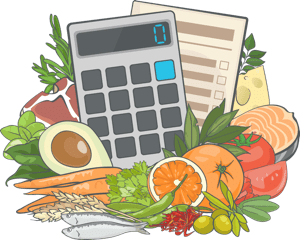
© Precision Nutrition
To use it, plug in your personal details and goals, and you’ll get your estimated daily calorie needs.
If you use our calculator, you can just skip Step 2 below. Because along with your calorie estimates, you’ll also get recommendations for your ideal macronutrient ratio—or the option to customize it yourself.
Option 2: Use the chart below.
For people who love by-hand calculations, we’ve got you.
First, find your activity level and goal below.
Then, multiply your bodyweight in pounds by the corresponding multiplier.
Daily calorie estimator
| Client goal | |||
| Lose weight | Maintain weight | Gain weight | |
| Lightly active (<3 hrs / wk) |
10-12 | 12-14 | 16-18 |
| Moderately active (3-7 hrs / wk) |
12-14 | 14-16 | 18-20 |
| Very active (<7 hrs / wk)* |
14-16 | 16-18 | 20-22 |
* Competitive athletes—who are often active for over 15 hours per week—have even higher needs.
For example, a lightly active 170-pound person who wants to lose weight would eat between 1,700 and 2,040 calories each day.
Women should generally start at the lower end of the range, and men at the higher end. Or, start in the middle and see what happens. If you’re not seeing the desired results, adjust calorie intake up or down accordingly.
Note: These short-hand multipliers become less accurate as you move away from “average” body weights. For individuals who are very light, very large, or very muscular, our macros calculator above might be more accurate.
Step 2: Determine your macronutrient ratio.
Your macronutrient ratio (also called your “macronutrient split”) refers to how much of each macronutrient you’re eating.
For most people, a good split is 15 to 35 percent protein, 40 to 60 percent carbohydrates, and 20 to 40 percent fat.
(This is just a framework. You can modify these proportions according to your preferences. And if you follow a high fat or high carb diet, your numbers may go outside these ranges.)
By adjusting your macro ratio based on your age, sex, activity levels, goals, and preferences, you can personalize your eating plan for your optimal health.
Use our Macros Calculator as mentioned above, or the formulas below.
We’ll cover each macronutrient one at a time.
Protein
Your protein needs will depend on your weight, activity level, and goals.
We calculate protein first because it’s essential for so many aspects of good health, including fat loss, muscle gain and maintenance, and athletic performance and recovery.
Use the charts below to figure out how much protein you need in grams per pound or kilogram of bodyweight.
| PROTEIN NEEDS IN G/LB | |||
| Maintenance / improve health | Fat loss / body recomposition | Muscle gain | |
| Lightly active (<3 hours/week) |
0.6 to 0.9 | 0.7 to 1.0 | 0.8 to 1.1 |
| Moderately active (3-7 hours/week) |
0.7 to 1.0 | 0.8 to 1.1 | 0.9 to 1.2 |
| Highly active (>7 hours/week) |
0.8 to 1.1 | 0.9 to 1.2 | 1.0 to 1.3 |
| PROTEIN NEEDS IN G/KG | |||
| Maintenance / improve health | Fat loss / body recomposition | Muscle gain | |
| Lightly active (<3 hours/week) |
1.3 to 2.0 | 1.5 to 2.2 | 1.8 to 2.4 |
| Moderately active (3-7 hours/week) |
1.5 to 2.2 | 1.8 to 2.4 | 2.0 to 2.6 |
| Highly active (>7 hours/week) |
1.8 to 2.4 | 2.0 to 2.6 | 2.2 to 2.9 |
If you’re new to healthy eating or have a hard time getting protein into your diet, start with the lower end of the range.
If you’re ready for more advanced nutrition protocols, or you’re a dedicated exerciser, aim for the higher end.
So, a 170-pound nutrition beginner who’s lightly active and wants to lose fat might choose the factor 0.8 g/lb from the range 0.7 to 1.0.
170 pounds x 0.8 = 136 grams of protein / day
A highly active 165-pound experienced lifter who wants to gain muscle might choose the factor 1.2 g/lb from the range 1.0 to 1.3.
165 pounds x 1.2 = 198 grams of protein / day
Note: For professional athletes, lean individuals trying to get very lean, and experienced lifters trying to minimize fat gain when adding body weight, protein requirements may go as high as 1.5 g/lb or 3.3 g/kg.
Fat & Carbohydrates
How much you eat of these two macros depends on, well, what you like.
First, figure out how many calories and what percentage of your macros you have left over after protein.
The formula looks like this (recall each gram of protein has four calories):
Total calories – (Total grams of protein x 4 calories) = Fat and carb calories
To get your protein percentage, divide calories from protein by total calories:
Calories from protein / Total calories = Percent of total calories from protein
Now, subtract your percent of protein from 100 to get your percent of fat and carbohydrates. (Home stretch, folks!)
100 – Percent of calories from protein = Percent of fat and carbs
Then you can decide how you want to split fat and carbs.
Here are some factors to consider:
- In general, the more active you are, the greater your carbohydrate needs.
- The minimum threshold for fat is 15 to 20 percent of total calories.
- Research shows that low-fat and low-carb diets work equally as well for weight loss.1
Let’s say, after a person subtracts their percent of calories from protein, they have 75 percent of calories left over to use on either fat or carbs. And they decide to do 50 percent carbs (4 calories per gram) and 25 percent fat (9 calories per gram).
Here’s how to do the math:
Carbohydrates:
Total calories x 0.5 = Carbohydrate calories
Carbohydrate calories / 4 = Grams of carbohydrates
Fat:
Total calories x 0.25 = Fat calories
Fat calories / 9 = Grams of fat
Keto macros: How low carb can you go?
The ketogenic diet was originally developed to treat epilepsy. Physicians discovered that fasting reduced the frequency of seizures, but so did an extremely low-carb diet.
Eventually, bodybuilders and fitness enthusiasts got wind of the diet and thought, ‘If the ketogenic diet mimics fasting, maybe I can get ripped without having to drop calories too low and lose all my gainz.’
A couple of decades later, everyone is eating cauliflower-crust keto pizza. (It’s actually pretty good.)
In terms of the macros split, the ketogenic diet consists of about 70-90 percent calories from fat, with the remaining 10-30 percent of calories coming from a mix of carbohydrates and protein combined.
(For comparison, a standard “low carb” diet is about 50 percent fat, 30 percent protein, and 20 percent carbohydrate.)
Unless you’re trying to stay in ketosis for medical reasons (to reduce seizures), less strict versions of the keto diet—which allow higher amounts of protein and carbs—are more sustainable for most people, especially athletes trying to maintain performance and muscle mass.
(Interested in trying—or coaching—the ketogenic diet? Here’s your primer: The Keto diet plan: Your complete how-to guide.)
How to track your macros
Once you’ve determined your macros, you’ll want to track them to ensure that you’re meeting your macronutrient goals each day.
Most people use an app like MyFitnessPal, Cronometer, or Macros+.
There are a couple of advantages to using an app:
- You have a quick reference guide for how much of each macronutrient a serving of a food contains
- The app will add up your macros for you (and let you know how many you have left for the day)
Or, you can keep track of your macros by hand, using a paper journal and a nutrition database like the USDA’s Food Data Central or SELFNutritionData.
With either approach, record the foods you’ve eaten at each meal, along with how many grams of each macronutrient each food contains.
Many people find it helps to plan meals the night before or the morning of. This helps you strategize ahead of time, building meals that meet your macro goals, instead of choosing food reactively when you’re starving and—oh man, that giant burrito looks good.
Most apps also allow you to save meals. So if you tend to repeat meals every once and awhile, having pre-entered and -calculated food combinations can make tracking more efficient.
If you plan on dining out, logging ahead of time can be a good strategy for sticking to your macros. Check out the menu before you get to the restaurant, and do your best to estimate the macros of the meal you’ll order.
5 common questions about macro tracking
Once you’ve figured out your macro numbers, you might feel like you have the key to all your future health and fitness goals.
Until you actually have to eat.
“Wait…how do I do this in real life?!”
Here are some of the most common questions people have about tracking macros, and what to do.
Question 1: What do you eat on a macro diet?
As you get used to tracking your macros, you’ll learn which foods are high in protein, carbs, and fat.
But one thing macronutrient counting doesn’t take into account is micronutrients (vitamins and minerals, usually found in whole, minimally processed foods).
Micronutrients are necessary for good health. And though you probably could hit your macros by crushing pizza, french fries, and protein shakes, we wouldn’t suggest it.
As a macro counter, it’s up to you to ensure you eat a diet that meets your macro- and micronutrient needs.
One simple way to do that?
Hit your macros primarily through a variety of minimally processed foods that are naturally rich in micronutrients: lean proteins, fruits and vegetables, whole grains and legumes, nuts and seeds, and pressed oils.
If you’re not sure where to start, check out the graphic below. You can see that while some foods fit neatly into certain macronutrient categories, other foods are more of a mix.
(For a more detailed version of the above image, check out our handout: The Macros Chart.)
Question 2: How do I measure my food?
It’s not quite Sophie’s choice, but people still wonder:
Should I measure food by volume (with a measuring cup) or by weight (with a food scale)?
Use a food scale for the best results. Measuring by weight will always be more accurate than measuring by volume.
For example, depending on whether they’re whole or chopped, a cup will fit about 100 grams of almonds. But if those almonds are finely chopped, they’re easier to pack in, and a cup may fit 200 grams.
On a scale, 100 grams will always be a 100 grams, no matter if the almonds are whole or chopped.
But if your only option is measuring cups and spoons, that’s ok. Just be sure—especially in the beginning—to measure everything, rather than eyeball it.
People tend to overestimate what a “tablespoon” or “cup” looks like, sometimes unintentionally doubling their portion.
Note: Cooking certain foods like grains, pasta, and meat, can change their weight and volume. So, if you measure a food raw, log it raw. If you measure it cooked, log it cooked.
If weighing and measuring your food feels tedious and soul-shrivelling, there are other tracking options.
For example, you could track your intake using hand portions. Our Macros Calculator provides hand portions too, so you don’t have to meticulously measure everything (unless you want to).
(Learn all about hand portions here: How your fist, palm, cupped hand, and thumb can help you avoid the hassle of counting calories.)
Question 3: How important is it to precisely hit my macros?
Consistency will get you the results you want.
But that doesn’t mean you have to hit your macros exactly every single day.
If you’re having a bad week (or year) remember that 50 percent consistency is better than giving up completely.
(Need proof that you don’t need to be perfect to get results? Read: One million data points show what it REALLY takes to change your body.)
If you feel like you’re really flailing, just prioritize meeting your protein goals each day. A diet higher in protein will help reduce hunger, preserve muscle, and help improve overall health.
Overall, aim for consistency over perfection. Try to get close to your daily macro goals, but don’t force yourself to eat if you’re not hungry.
And if you’d rather have half an avocado than a bowl of oatmeal? Don’t stress about swapping fat for carbs.
Question 4: Can you use macros for weight loss?
If your goal is to lose fat, it’s a good idea to use some kind of method to track food intake, at least for a period of time.
Many people use calories. But macros account for calories, and have the added value of telling you a bit more about food quality (like the amount of protein, fat, or carbohydrate in a food).
Especially for weight loss—where the goal is usually to lose fat but maintain lean mass—tracking macros can help ensure you get enough muscle-preserving protein while still eating fewer calories than you burn.
Use the protein recommendations chart above to find the protein range for your goal and activity level. If your goal is to lose fat, minimize hunger, and preserve muscle mass, choose the upper end of your range.
From there, figure out your carb and fat allowances, remembering that to lose fat, you have to eat fewer calories than you burn—also called a calorie deficit—for a period of time.
Question 5: How do I track alcohol?
Just because alcohol isn’t included in typical macro plans doesn’t mean you can’t have it.
But you should track it, since it contains calories.
The most common way to do this is to use some of your fat or carbohydrate grams to account for the alcohol.
For instance, if you’re having a beer, 12 ounces is approximately 155 calories.2
If you want to exchange it for carbohydrates, do the following equation:
155 calories / 4 calories per gram = 38.75 grams
So you could log your lager as 39 grams of carbs.
Or if you’re having a glass of red wine, a 5-ounce serving is 127 calories.3
To use fat grams for that glass:
127 calories / 9 calories per gram = 14.1 grams
So you could log your vino as 14 grams of fat.
Or, just use a combination of carbs and fat, by dividing the calories however you see fit and repeating the steps above.
What to do next
Ready to get started? Here are some things to keep in mind before you begin.
Know what you hope to accomplish.
Macro counting works well for people with specific goals.
As you progress towards or even achieve your goal, consider if you want to continue counting macros. Some people enjoy counting them indefinitely, but most eventually get tired of tracking.
Truth is, macro counting is just one of many nutrition strategies you can add to your toolbox.
(Want another awesome strategy? Read: The 30-day eating challenge that can blow your mind—and transform your body.)
Treat macro counting as an experiment.
The first macro split you try might work great. Or not.
Whether you succeed or fail, don’t use it as a proxy for your self-worth.
Gather your data, and just see what happens. Stay open-minded, and use the outcome of your experiment to inform your next choices.
Did you enjoy tracking macros, and feel closer to your goals? Cool! Keep going.
Did all the measuring and counting feel too finicky and left you stressed out? Try a different way of improving your nutrition.
(And if you REALLY loved working with macros, you might like our continuing education course: How to Coach a Macros-Based Diet.)
It’s okay if macro counting isn’t for you.
Full disclosure: At Precision Nutrition, macronutrient counting isn’t our go-to method of regulating food intake. At least, not for most people.
Macro counting works—especially for high-level, advanced goals, like preparing for a physique competition or a major athletic event.
But despite the fact that macro counting can be super flexible, it’s also a lot of work. Especially compared to other methods of “watching what you eat,” which can be just as effective.
For most people and most goals, there are less labor-intensive ways to get results. Here are some ideas:
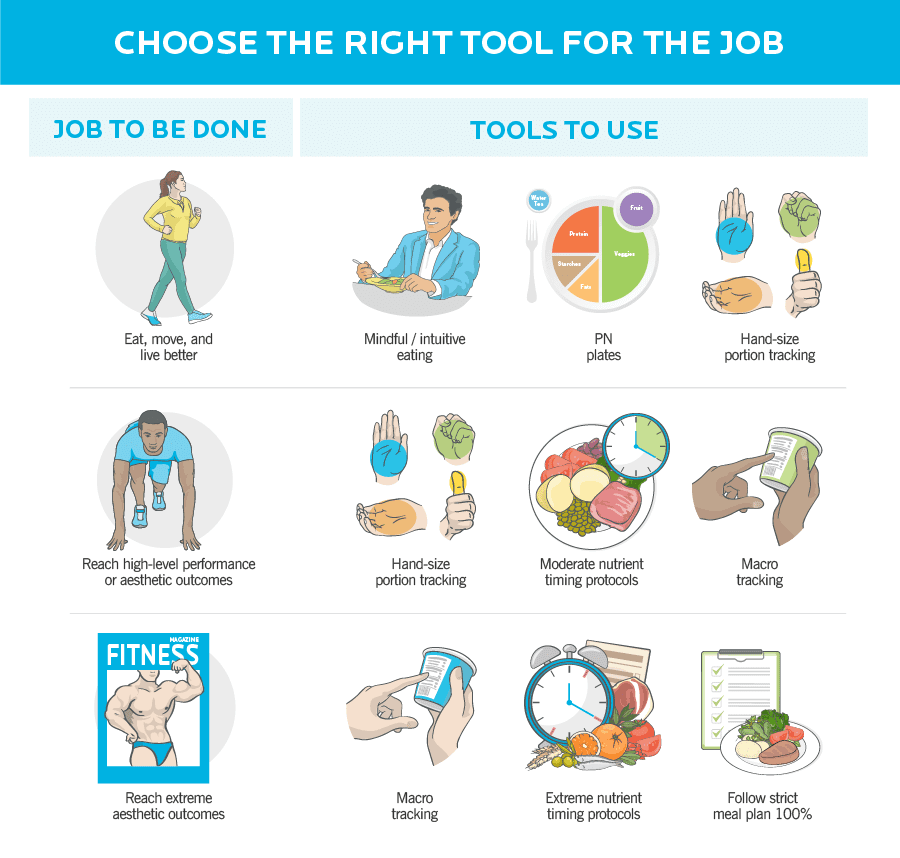 (Want to compare different methods of food tracking? Read: Macros vs. calories vs. portions vs. intuitive eating.)
(Want to compare different methods of food tracking? Read: Macros vs. calories vs. portions vs. intuitive eating.)
Remember that we eat food, not nutrients.
Food is so much more than grams of protein, carbohydrates, and fat. And meals aren’t just a chance to hit your macro goals.
Meals are also an opportunity to experience pleasure, spend time caring for your body, and share with people you love.
Every meal is a chance to connect—with yourself and with others. And every food choice is an opportunity to direct, shape, and remake your health.
References
Click here to view the information sources referenced in this article.
If you’re a coach, or you want to be…
You can help people build sustainable nutrition and lifestyle habits that will significantly improve their physical and mental health—while you make a great living doing what you love. We'll show you how.
If you’d like to learn more, consider the PN Level 1 Nutrition Coaching Certification. (You can enroll now at a big discount.)

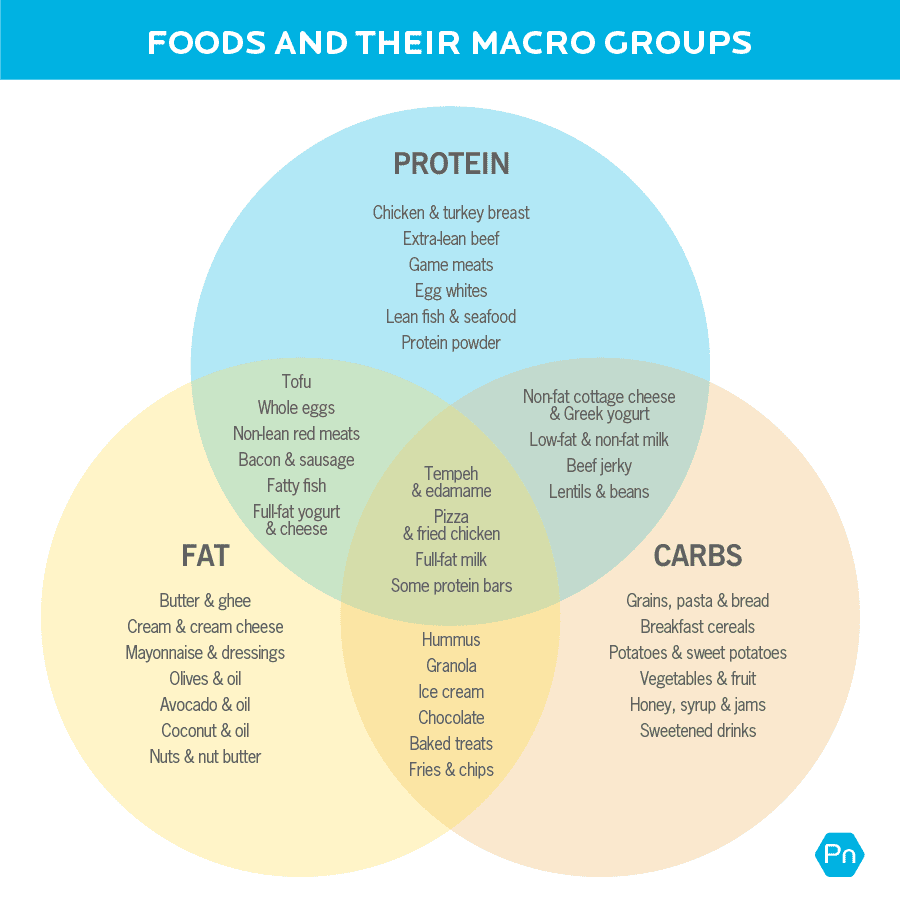

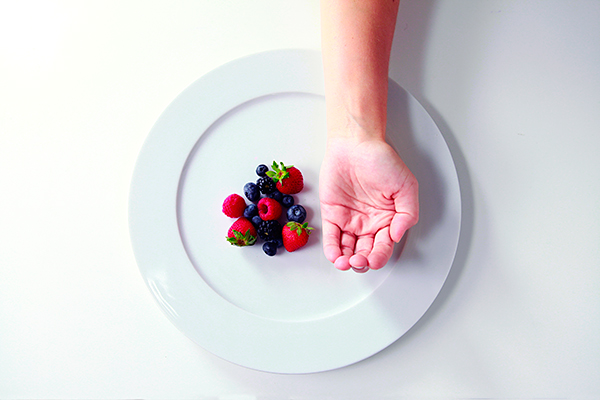

Share